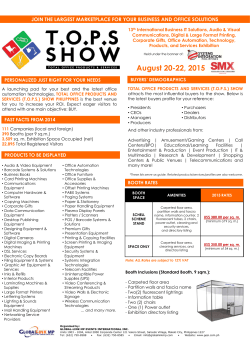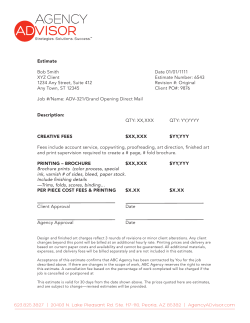
18 3D Printing, Arduinos and other Open Source Tech in STEAM
AAAS Pacific Division 2015 San Francisco Meeting Symposium Abstracts 18 3D Printing, Arduinos and other Open Source Tech in STEAM Learning The New Shop Class: A Survey of Maker Technologies and Their Use in Educational and Scientific Applications, JOAN HORVATH* and RICH CAMERON* (Nonscriptum LLC, 155 N. Lake Ave, Suite 800, Pasadena CA 91101; joan@nonscriptum.com, rich@nonscriptum.com). Students have always made things in school and scientists have created lab equipment, but the availability of digital manufacturing tools has changed drastically in the last decade. What happens when the cost of fabricating near-professional-quality prototypes and electronics falls? What is involved in using these technologies (like 3D printing, Arduino microprocessors, and wearable electronics) in the classroom? This paper will introduce the session and will describe the experiences of some early adopters, and the cultural issues that arise when crossing over formal education and the hacker culture. The authors will describe ways forward for educational institutions wanting to learn more about using these technologies for low-cost yet powerful applications in citizen science, ecosystem modeling, learning assistance for the visually impaired and even theatrical applications. 3D Printed Coral: A Study in Replicating Natural Habitat, TOM HAGLUND1, REGINA RUBIO*1, SIMON HUSS1, GLEN CHUNG1, JOAN HORVATH2 and RICHARD CAMERON2 (1Windward School, 11350 Palms Boulevard, Los Angeles, California 90066; 2Nonscriptum LLC, 155 N. Lake Ave, Pasadena, CA 91101; rrubio@windwardschool.org). Coral reefs are dying in many parts of the world due to climate change, pollution and other factors. Entire ecosystems depend on coral to provide habitat. We 3D scanned several pieces of biological coral and then 3D printed replicas as accurately as possible on a consumer-level 3D printer. The coral was printed in natural (no dye added) ABS, soaked in fresh water to leach out salts and other contaminants, and then placed along with biological coral in a saltwater aquarium. This paper will give the impact on the aquarium ecosystem, the reactions of the fish to the 3D printed coral, and other observations on the implications of this experiment. The authors will speculate on other possible applications of this technology to maintenance and repair of damaged ecosystems. 3D Printers as Tools in the STEM Classroom, CHRISTINE MYTKO* and JANE YARNELL* (Black Pine Circle School, 2027 7th St, Berkeley, CA 94710; cmytko@blackpinecircle.org). As the technology becomes more widely accessible, STEM education is being redefined to include new, innovative tools for physical computing and fabrication. A middle school teacher shares her journey with 3D printing from the introduction of the novel machine to its integrated use as a classroom tool for data visualization, inquiry-based science, student expression, cross-curricular connections, and more. Her student will join her to discuss her own experience with 3D printing in the classroom and both will discuss the potential of 3D printers to change the future of STE(A)M education. Engineering Design at Bullis Charter School. DAVID MALPICA (Bullis Charter School, 102 W Portola Ave Los Altos, CA 94022; dmalpica@bullischarterschool.com). This year, along with our longstanding 7th grade engineering design intersessions, we ran a pilot program to introduce sixth grade students to engineering design as described in the Next Generation Science Standards. Students had two 65 minute periods a week every trimester. The engineering design process was slowly introduced around three main projects: 1) Computer Science (game programming), 2) Product Design (laser cut physical devices), and 3) Electrical Engineering (light emitting object design). The presentation will center on the second and third project and lessons learned throughout the year. Makerspaces - Bolt-on or Integrated, PARKER THOMAS (305 Regent St., Alameda, CA 94501; me@ParkerThomas.com). A CNC machine, 3-D printers, Dremels for everyone, a laser cutter and a screwdriver. What do they have in common? They will all gather dust if you buy them for a makerspace without first stopping to think about how they will be integrated into the culture, curriculum and community of your school. This talk will describe a process to plan a space and integrate the makerspace into the life of your school. 3D Printing for Accessible Instructional Materials, YUE-TING SIU (San Francisco State University, Visual Impairment Program, 1930 Channing Way, #1A, Berkeley, CA 94704; ting@tplus.education). As 3D printing gains popularity in the education sector, considerations for meaningful representation of visual media are necessary to ensure truly accessible instructional materials. This discussion will present best practices in developing and using 3D printed objects with students who are blind or visually impaired, and offer suggestions for relevant application. Inclusion of 3D printing as a tool for accessible media requires community-based scaffolding – participants will also be challenged to contribute creative solutions to bridge the technology with teachers and students who can benefit from its use. 3D Printing: New Educational Opportunities for Students with Print Disabilities, LISA WADORS VERNE (Benetech, 480 S. California Ave, Suite 201, Palo Alto, CA 94306; lisaw@benetech.org). The revolution in affordable 3D printing solutions has the potential to change the world for many people with print disabilities, such as visual impairment and learning disabilities, giving them even better access to complex spatial and visual information. The DIAGRAM (Digital Image And Graphic Resources for Accessible Materials) Center is conducting research into new and transformative ways that 3D models can be used to revolutionize accessibility in educational contexts. Using the results of our research and the availability and uses of 3D printing in schools, we are developing strategies to make the creation and dissemination of these models easier and within the reach of more students. Physical Biomodeling, Peppytide and PeppyChain Models for Protein Folding, PROMITA CHAKRABORTY (QuezyLab, C/o Innowest 764 San Aleso Ave, Sunnyvale, CA, 94085; promita@quezylab.com). Physical Biomodeling is a new field of study to conceptualize a vision of CAD-cum biocomputationcum-3Dprinting platforms for bringing together nano-scale functions and dynamics of biosystems and the manipulated-by-hand world of physical bio-models without compromising on accuracy of scale or properties. These guiding principles have been incorporated in a prototype of polypeptide chain for protein folding, called Peppytide, that not only serves as a proof-of-concept, but also is the first of its kind. Peppytide 2 and PeppyChain models build on top of that to implement replaceable side chains so that one can make any sequence of amino acids to experiment with folding.
© Copyright 2025





















